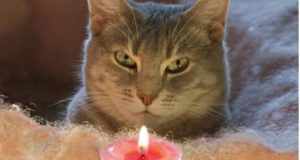
Tips for a Cat Safe Home
Keep Your Cat Safe at Home
Preparing to bring home a new kitten is comparable to child-proofing for an active toddler. Kids and cats like to play and explore, but can easily get themselves into trouble. As pet parents (or parents of a child), it is our responsibility to provide a safe environment for our loved ones, and to help them grow up healthy and strong.
There are obvious dangers to a pet in the home, and others that might not be immediately apparent. Adopting an animal is a happy, nurturing experience for most families, but it’s important to take precautions and be ready. Keep your cat out of harm’s way by reviewing these recommendations.
Beware of Poisonous Plants
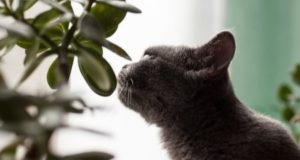 Cats love to chew on plants and grass, but some will make them sick, and others can be deadly. Common household plants such as azaleas, rhododendrons, and lilies can be toxic if eaten by pets. Even some non-poisonous plants may cause vomiting and diarrhea. Become aware of which plants are cat-friendly. Check the list of household plants toxic to felines, or contact the ASPCA Animal Poison Control Center, if you’re unsure of the toxicity level of plants around your home and yard.
Cats love to chew on plants and grass, but some will make them sick, and others can be deadly. Common household plants such as azaleas, rhododendrons, and lilies can be toxic if eaten by pets. Even some non-poisonous plants may cause vomiting and diarrhea. Become aware of which plants are cat-friendly. Check the list of household plants toxic to felines, or contact the ASPCA Animal Poison Control Center, if you’re unsure of the toxicity level of plants around your home and yard.
A safe alternative is to buy or grow your own cat grass. Oat, wheat, barley or rye grass are known as cereal grasses. Not only are they nutritious and delicious to cats, but the chlorophyll in the grass helps improve kitty breath. Grass is also a natural fiber, which helps to get rid of hairballs. You can purchase wheat grass at your local grocery store and Chewy.com, preferably organic wheat grass.
Lock up Cleaning Supplies
 Our homes are filled with chemicals that are dangerous to pets. Common household cleaners like detergents, bleaches and disinfectants can be poisonous, even if a cat walks on a treated floor or counter, and then licks its paws. Many cleaning supplies contain a mixture of chemicals that are poisonous, caustic, or fatal to felines, including Drano, Ajax, and products containing pine oil. Make sure cleaning products are stored safely in cabinets and out of the cat’s reach. For a greener and more cat-friendly option, try cleaning with vinegar and baking soda.
Our homes are filled with chemicals that are dangerous to pets. Common household cleaners like detergents, bleaches and disinfectants can be poisonous, even if a cat walks on a treated floor or counter, and then licks its paws. Many cleaning supplies contain a mixture of chemicals that are poisonous, caustic, or fatal to felines, including Drano, Ajax, and products containing pine oil. Make sure cleaning products are stored safely in cabinets and out of the cat’s reach. For a greener and more cat-friendly option, try cleaning with vinegar and baking soda.
When cleaning, it is best to keep cats in a separate area until chemical fumes have dissipated and the cleaning mixture has dried completely to avoid inhaling chemicals or getting them on your cat’s paws or fur.
Put Medicines Away
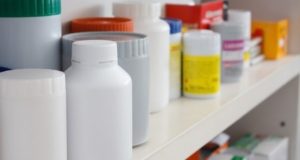 The pill bottle on the counter looks like a super fun toy to your cat. But childproof lids are not necessarily cat-proof, and spilled pills could be mistaken for treats. Even over the counter painkillers such as ibuprofen and aspirin can cause serious stomach problems for pets, or worse yet, kidney or liver failure. About half the animal poisonings reported are due to accidents involving human medications, so keep them tucked away. Review list of human medications harmful to pets.
The pill bottle on the counter looks like a super fun toy to your cat. But childproof lids are not necessarily cat-proof, and spilled pills could be mistaken for treats. Even over the counter painkillers such as ibuprofen and aspirin can cause serious stomach problems for pets, or worse yet, kidney or liver failure. About half the animal poisonings reported are due to accidents involving human medications, so keep them tucked away. Review list of human medications harmful to pets.
Be on the lookout for other common household items that can seriously harm your cat if eaten. Among them batteries, mothballs, fabric softener sheets, laundry detergent packs, automatic dishwasher detergent packs, coffee grounds, alcohol, and chocolate.
[The next 3 items most likely will be found in your garage or yard. We still include them even though we hope you choose to keep your kitty as an indoor only one for his health and safety. Although we do our best to keep our cats indoors, sometimes they escape (especially with young children at home) thus, it is very important to be aware of these items which can be deadly to our cats. It is also a reminder about why it is important to keep cats indoors as we can’t control what they will encounter on a neighbor’s property (this includes toxic plants as noted above).]
Keep Automotive Products Locked Away
Although these products are generally kept in the garage, it is still important to keep them in a childproof cabinet. Antifreeze and windshield wiper fluid contain ethylene glycol, which has an inviting aroma and sweet taste to pets and children. Unfortunately, it is estimated that over 10,000 pets die each year from accidental ingestion of these highly poisonous automotive products.
Keep Rat/Mouse Poison or Insect Baits Inaccessible
Many rodenticides (rat/mouse poison) contain warfarin or brodifacoum, which reduce blood clotting and cause internal bleeding. Insect baits may contain hazardous substances such as organophosphates, which may affect your cat’s nervous system.
Prevent Access to Fertilizers, Herbicides, or Insecticides
Many of these products use chemicals to kill insects or weeds or promote plant growth in gardens. Unfortunately, while these may help keep your yard free from pests, most are deadly to your cat.
Read Labels on Pet Products
Carefully read all labels on pet products. Some are made specifically for DOGS and should NEVER be given to or put onto a cat. A good example of this is pet flea and tick topicals. Many products that help protect dogs from fleas and ticks contain permethrin, which is a synthetic insecticide that is extremely dangerous – and potentially fatal – to cats.
Same goes for pet food. Never feed dog food to cats exclusively. Felines require specific Vitamin A whereas dogs can make do with beta carotene instead (their bodies can turn it into vitamin A). All cats require Taurine, an amino acid which dogs can make their own. Thus, many dog foods may be deficient in taurine, the result being a cat will suffer a devastating kind of heart disease called hypertrophic cardiomyopathy if fed only dog food or a nutritional incomplete cat food. This also happens when cats eat a fish-only diet, since fish meat is so deficient in this amino acid. In addition, Arachidonic acid is a fatty acid dogs can build themselves, while cats need the real thing from their cat food. Protein levels are another big reason not to feed cats dog food. Though some dog foods do offer very high levels of protein, most do not reach the percentage of protein our carnivorous cats require.
Check Large Appliances
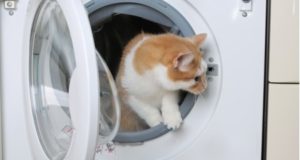 Cats love to seek out warm, cozy spots for curling up and taking a nap. There are lots of those places in your house, especially the dryer. Always look inside the dryer before you start it, and try to keep the door closed when it’s not in use. Be careful and prevent disaster. Kittens can also easily climb into refrigerators, cabinets and dresser drawers, so check inside those before closing them.
Cats love to seek out warm, cozy spots for curling up and taking a nap. There are lots of those places in your house, especially the dryer. Always look inside the dryer before you start it, and try to keep the door closed when it’s not in use. Be careful and prevent disaster. Kittens can also easily climb into refrigerators, cabinets and dresser drawers, so check inside those before closing them.
Hide the Cords
 What cat doesn’t like to play with strings, especially if they’re dangling from the windows? Examine the blinds in your home. They could be a potential hazard. Kittens have been known to get stuck in mini blinds and tangled in the cords. Make sure to tie up the cords and tuck them away, out of sight and reach of the cat.
What cat doesn’t like to play with strings, especially if they’re dangling from the windows? Examine the blinds in your home. They could be a potential hazard. Kittens have been known to get stuck in mini blinds and tangled in the cords. Make sure to tie up the cords and tuck them away, out of sight and reach of the cat.
Prevent your cat from chewing on electrical cables. Unplug them when you’re not home or consider these suggestions: hide cords under a rug, duct tape them to the floor or to the side of the appliance, or buy chew-proof cable protectors. You can also use a non-toxic spray on your electronics that tastes bad to cats.
Be Careful with Candles
They fill a room with light and fragrance, but untended candles could be disastrous. If your pet is freely roaming the house, don’t leave a room with candles burning. A playful kitten could walk by and singe its fur, burn its skin, or knock over a candle and set the house on fire.
Put Breakable Treasures Away
 Cats love to climb and explore on tables, counter tops or even bookshelves. At least while you have a kitten, think about removing fragile items from open spaces. Broken glass and china are sharp obstacles for little paws, and potentially lethal if chewed or swallowed. Protect your cat by putting breakables away.
Cats love to climb and explore on tables, counter tops or even bookshelves. At least while you have a kitten, think about removing fragile items from open spaces. Broken glass and china are sharp obstacles for little paws, and potentially lethal if chewed or swallowed. Protect your cat by putting breakables away.
Search for Choking Hazards
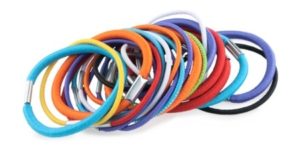 In every room of your house there are probably items small enough for a cat to choke on. Take a few minutes to look around and make some changes. Cats go crazy over hair supplies, especially ribbons and hair ties. Store them in a drawer.
In every room of your house there are probably items small enough for a cat to choke on. Take a few minutes to look around and make some changes. Cats go crazy over hair supplies, especially ribbons and hair ties. Store them in a drawer.
Strings or threads of any kind can cause intestinal problems or get stuck in a cat’s throat. A cork can be fun to chew on, but little pieces break off and can also cause a cat to choke. Look out for cellophane, rubber bands and dental floss.
No Pennies, Paint Chips, Screws, Nails, etc.
Many of these products contain heavy metals, such as zinc or lead, that are harmful to animals, including cats. In addition, these foreign bodies can become lodged or trapped in your cat’s esophagus, stomach, or intestines and cause injury or death. At the very least, many accidental ingestions of such products require emergency surgery for removal.
Close the Lid
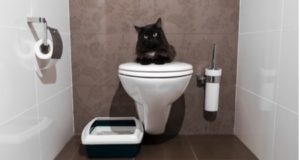 Remember to keep the toilet lid down, so the kitty doesn’t fall in. It might be a good idea to leave a note to remind guests to close it as well. A thirsty kitten could fall in the bowl and not to be able to climb out.
Remember to keep the toilet lid down, so the kitty doesn’t fall in. It might be a good idea to leave a note to remind guests to close it as well. A thirsty kitten could fall in the bowl and not to be able to climb out.
You also don’t want your feline friend drinking out of the toilet bowl which may have flushable toilet bowl cleaners in the water.
What about the Windows?
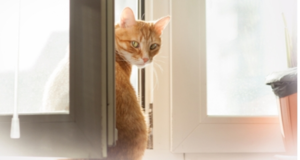 Do you keep windows open? Wide open, or just a crack? Are there sturdy screens on doors and windows to prevent a cat from sneaking out and getting lost, or falling off the ledge of an upper story window? These are some questions to ask yourself when a cat moves in. And talk to others who live with you. Encourage everyone in the house to get on the same page regarding the care of your new cat, to ensure its health and safety.
Do you keep windows open? Wide open, or just a crack? Are there sturdy screens on doors and windows to prevent a cat from sneaking out and getting lost, or falling off the ledge of an upper story window? These are some questions to ask yourself when a cat moves in. And talk to others who live with you. Encourage everyone in the house to get on the same page regarding the care of your new cat, to ensure its health and safety.
To research other specific items, visit the ASPCA Animal Poison Control Center.

